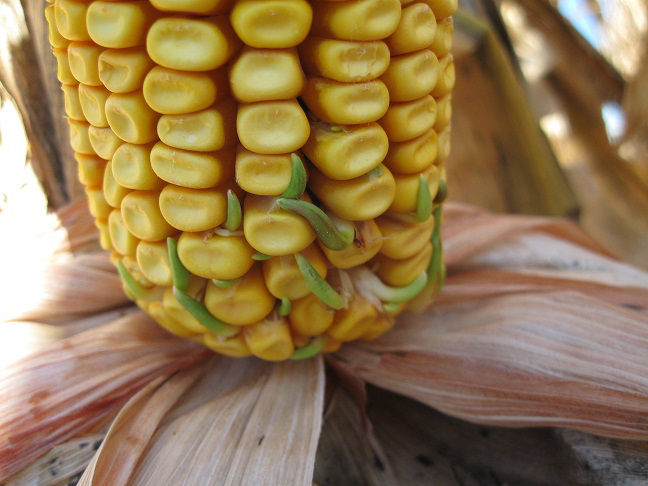3 MIN READ
Premature Corn Kernel Sprouting
August 31, 2023
- Corn kernel sprouting can occur under wet and warm conditions in the fall.
- Kernel sprouting is more likely to occur in corn products that tend to have upright ears and open husks at maturity.
- If kernel sprouting is suspected, harvest fields as soon as possible and dry corn at high temperatures.
Premature Corn Kernel Sprouting
Premature germination or sprouting of kernels prior to harvest is also known as vivipary. It primarily occurs when moisture becomes trapped in the husk, allowing kernels to absorb water and germinate (Figure 1). However, premature sprouting may be caused by ear rots or a combination of other factors, such as erect ears trapping moisture, bird injury, or insect injury. Premature sprouting also occurs when ears on lodged stalks are lying on or near the soil surface. The closeness of the ears to moist soil allows re-wetting of the kernels and extensive germination on the cob. This type of kernel sprouting is usually limited within fields, but if evident across a field it has the potential to cause drying and storage problems.

Kernel sprouting on the cob prior to harvest is most likely to occur when black layer has been reached, kernel moisture has dried to less than 20 percent, and kernels are exposed to moisture. It is more common in warmer conditions. Corn products that tend to have an upright ear with an open husk at maturity may be more susceptible to kernel sprouting. Currently, it is believed that physical damage to the immature kernels may disrupt the hormone balance within the kernel and allow for early germination. When premature kernel sprouting occurs, seed quality will be compromised. Sprouted kernels are usually lighter, lower in test weight, and more susceptible to mold and mycotoxin development. These quality issues may result in the grain being discounted when marketed.
What Can You Do Now?
Sprouted kernels result in higher kernel damage and more fines. Key harvest management strategies include:
- Harvest early.
- Dry grain to 14% moisture content, potentially drying at a high temperature to kill sprouts.
- Screen out fines.
- Monitor stored grain closely for hot spots, mold, and additional sprouting grain.
- Core the stored grain after filling to remove additional fines or broken kernels from the center of the bin.
- If hail damage caused the sprouted kernels, inform your crop insurance adjuster and submit samples for kernel damage due to mold and sprouting.
- Have grain sampled for mycotoxins prior to harvest.
- If selling the grain, the grain dealer will be the entity that will decide whether to accept the load based on the damage and the dealer’s standards. If the load is rejected, contact your crop insurance agent to determine your next step. Do not bin the grain on your farm until you contact your insurance agent, as there will be specific steps that need to be followed when grain rejected due to mycotoxins or kernel damage from storms.
Sources
Nielsen, R.L. 2012. Premature corn kernel sprouting (aka vivipary). Purdue University. Corny News Network Articles. https://www.agry.purdue.edu/ext/corn/news/timeless/Vivipary.html
Rees, J., Cassman, K., Kruger, G., and Glewen, K. 2013. Sprouting corn kernels on hail-damaged ears. University of Nebraska - Lincoln. https://cropwatch.unl.edu/sprouting-corn-kernels-hail-damaged-ears
Paul, P. and Thomison, P. 2018. Premature Sprouting of Corn Kernels. Ohio State University. C.O.R.N. Newsletter. https://agcrops.osu.edu/newsletter/corn-newsletter/2018-33/premature-sprouting-corn-kernels
1214_63402